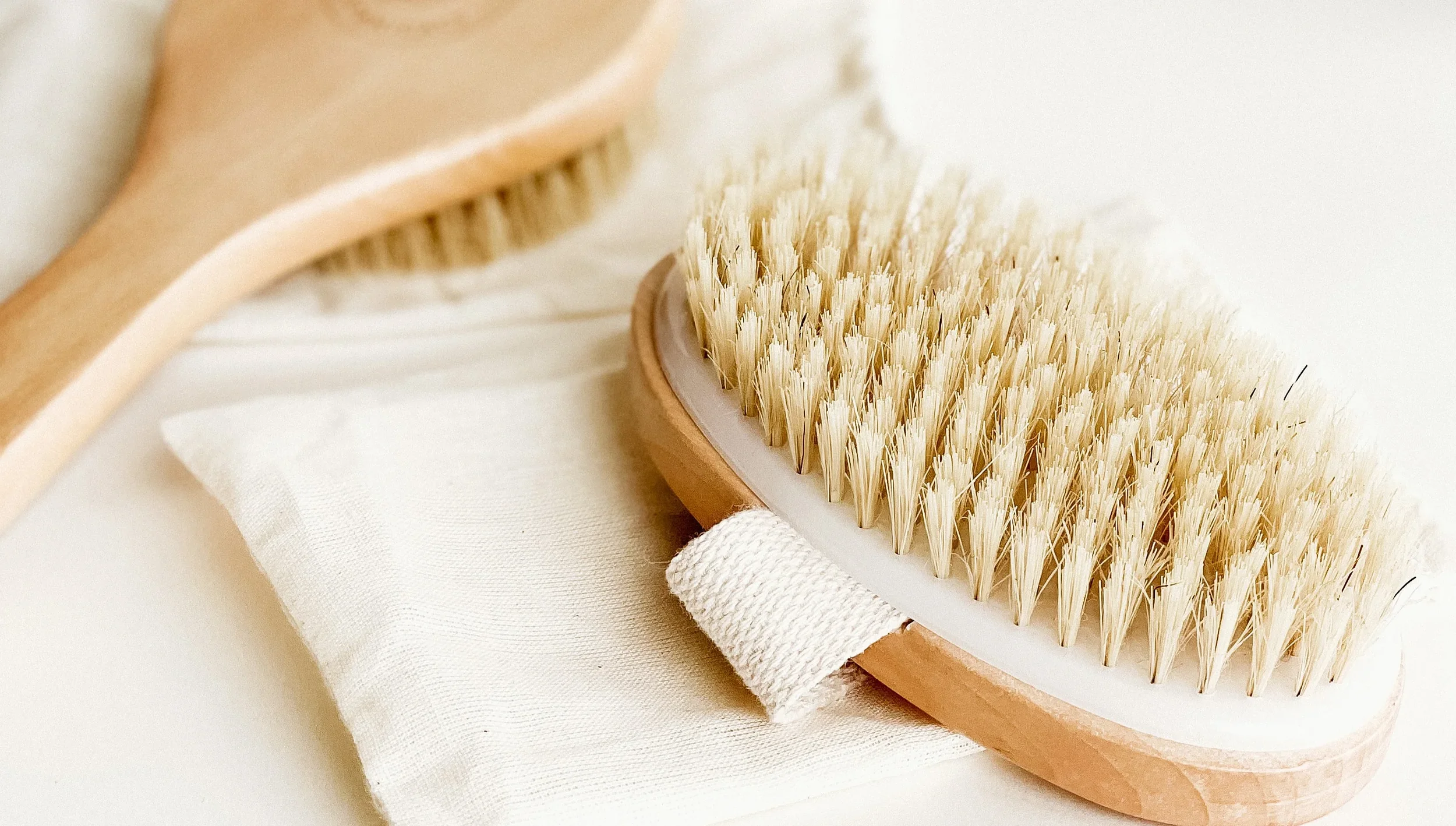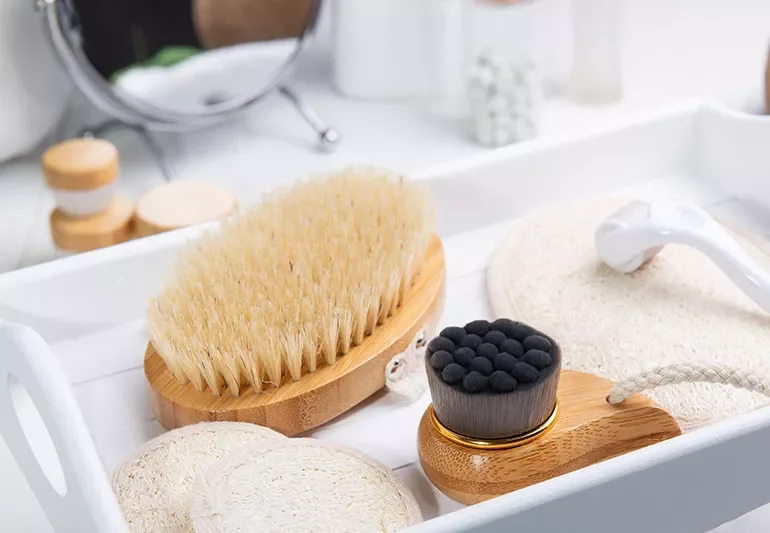Dry Brushing
Functional Profile of
Dry Brushing
Dry brushing is a topical practice that involves using a firm, natural-bristle brush on the skin in sweeping strokes, usually directed toward the heart. Traditionally used in European naturopathy, Ayurveda (garshana with raw silk gloves), and modern detox practices, it is valued for stimulating circulation, invigorating the skin, and moving lymphatic fluid. While not a “nutrient” remedy, it is a functional agent that mechanically engages the integumentary and lymphatic systems, supporting detoxification, renewal, and energy.
-
Ayurveda – Known as garshana, performed with raw silk gloves rather than bristle brushes. Used to stimulate lymphatic circulation, exfoliate, and awaken energy (prana).
European Naturopathy (19th century) – Adopted as part of hydrotherapy and detox regimens. Practitioners such as Sebastian Kneipp used brushing alongside cold-water therapies to invigorate circulation and support elimination.
Modern Wellness – Popularized as a beauty and detox practice, often recommended before bathing or sauna to improve skin tone, circulation, and lymphatic flow.
-
👉 Qualities describe the felt nature of a substance or practice, and how it acts in the body beyond nutrients or chemistry.
Stimulating (Circulating) – Activates circulation and lymphatic movement.
Drying – Exfoliates, reduces surface oils, and may aggravate dryness if overused.
Light – Creates a sense of invigoration and alertness.
Mobile – Promotes flow and disperses stagnation.
-
👉 Affinities describe which organ systems or tissues a practice most directly influences, showing where its actions are felt most strongly.
Primary Affinities
Lymphatic System – Encourages lymph movement and detoxification.
Integumentary System (Skin) – Improves circulation, exfoliates, and supports skin renewal.
Secondary Affinities
(Organs or systems that the remedy influences indirectly, or to a lesser degree than its primary targets.)Circulatory System – Enhances blood flow through mechanical stimulation.
Nervous System – Provides gentle sensory stimulation that can be invigorating or grounding.
-
👉 Terrain patterns describe the body’s functional state, showing when a food or practice is most helpful or aggravating.
👉 To learn more about these patterns in depth, read this blog.Primary Indication
Fluid Congestion in lymph and/or skin) – When tissues are boggy, swollen, or sluggish due to fluid buildup. Form & Application: Firm strokes with a dry natural-bristle brush, moving toward the heart.
Dose: 2–5 minutes before bathing, several times per week.Secondary Indication (Patterns a remedy can alleviate indirectly and over time.)
Hypofunction (Low circulation, sluggish metabolism) – Gentle stimulation awakens energy and promotes warmth in underactive systems. Form & Application: Short, brisk brushing sessions in the morning. Dose: 2–3 minutes to invigorate. -
Lymphatic Stimulation
Dry brushing creates mechanical pressure on superficial lymphatic vessels.
Lymph, unlike blood, has no central pump — it relies on movement, muscle contractions, and external stimulation to flow.
Brushing strokes directed toward the heart encourage lymph fluid drainage into larger lymphatic trunks, supporting detoxification and immune surveillance.
Microcirculation Enhancement
Stimulation of the skin and capillaries increases local blood flow, bringing oxygen and nutrients to tissues.
This effect may also contribute to warmth, tissue repair, and a subjective sense of vitality.
Exfoliation & Skin Renewal
Removes dead keratinocytes, unclogs pores, and improves turnover of skin cells.
Creates a healthier environment for the skin barrier and sebaceous glands.
Nervous System Effects
Light, repetitive stimulation of skin receptors activates the sensory nervous system, producing invigoration or alertness.
Depending on the individual, this may also have grounding or mildly stress-reducing effects via sensory integration.
Indirect Detoxification Support
By improving lymphatic flow and skin elimination, brushing may aid the body in clearing metabolic wastes and inflammatory mediators, indirectly supporting systemic detox pathways (liver, kidneys, skin).
-
Natural bristle brush – Applied to dry skin with firm but gentle strokes.
Direction – Always brush toward the heart to support lymphatic return.
Timing – Commonly practiced before bathing or sauna.
-
👉 Medicinal actions describe the specific ways a practice influences organ systems and body functions.
(Note: These are not pharmacological actions, but terrain-level influences that support balance in the body through lifestyle and environmental interaction.)
Lymphatic System
Lymphagogue (mechanical) – Stimulates lymphatic drainage through superficial vessel movement.
Detox-supportive – Indirectly aids clearance of wastes and inflammatory mediators via lymph.
Integumentary System (Skin)
Exfoliant – Removes dead skin cells, unclogs pores, and promotes skin renewal.
Circulatory stimulant – Increases microcirculation in the skin, enhancing oxygen and nutrient delivery.
Barrier-supportive – Prepares skin to absorb oils, moisturizers, or herbal infusions more effectively.
Circulatory System
Vasodilator (local) – Enhances superficial blood flow, producing warmth and improved tone.
Nervous System
Sensory stimulant – Activates cutaneous receptors, creating alertness, grounding, or invigoration.
Stress-modulating – Repetitive rhythmic brushing can regulate nervous tension for some individuals.
-
Second Degree – Noticeable systemic and local effects on lymph, skin, and circulation; safe for most constitutions, but can aggravate dryness or sensitivity if misapplied.
-
(Functional agents don’t usually have direct drug interactions, but may interact with other therapies.)
Topical treatments – May enhance penetration of herbal oils or medicated creams if applied afterward.
Concurrent detox therapies (e.g., sauna, fasting) – May amplify elimination and circulation effects.
-
Dry / Atrophy terrain – May worsen tissue depletion, thin skin, or dryness if overused; follow with oils or moisturizers.
Hyperreactivity (Sensitive skin) – Avoid on inflamed areas, eczema, psoriasis flares, wounds, or sunburn.
Pregnancy – Generally safe; avoid abdomen and sensitive areas.
Children – Safe if very gently applied; avoid strong pressure.
Overuse – Can cause microabrasions, irritation, or skin barrier disruption.
-
Traditional Sources
Kneipp, S. (1894). My Water Cure. (Dry friction and brushing as part of naturopathic hydrotherapy.)
Lad, V. (1990). Ayurveda: The Science of Self-Healing. Lotus Press. (Describes garshana as a form of Ayurvedic lymphatic massage.)
Modern Sources
Derya, K., et al. (2019). “Mechanical stimulation of lymphatic vessels and its role in lymphatic drainage.” Lymphatic Research and Biology, 17(3), 234–242.
Bosman, J., et al. (2014). “Skin barrier function and cosmetic practices: The role of exfoliation.” International Journal of Cosmetic Science, 36(3), 193–200.
Ernst, E. (2000). “The role of complementary and alternative medicine in dermatology.” Clinical and Experimental Dermatology, 25(5), 333–337.



